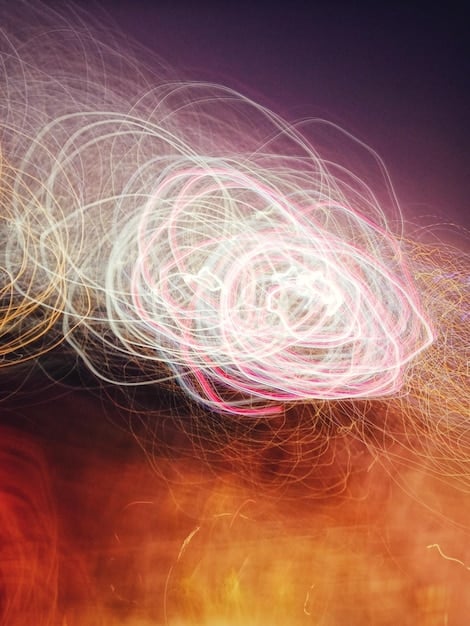Exploring ESP: The Science Behind Extrasensory Perception

Extrasensory perception (ESP), or the ability to perceive information beyond traditional senses, remains a debated topic; however, researchers continue to explore the science behind ESP through controlled experiments and analyzing anecdotal evidence, seeking to understand its potential mechanisms and limitations.
Can humans truly possess abilities beyond the five senses? The concept of extrasensory perception (ESP) has intrigued scientists and skeptics alike for decades. From telepathy to precognition, researchers are delving into the science behind ESP, attempting to uncover the potential mechanisms that could explain these extraordinary claims.
What is Extrasensory Perception (ESP)?
Extrasensory perception (ESP) refers to purported abilities to gain information through means beyond the traditional five senses: sight, hearing, smell, taste, and touch. It encompasses phenomena like telepathy, clairvoyance, precognition, and retrocognition, suggesting a potential for humans to perceive events or thoughts outside the normal sensory channels.
ESP, also known as the sixth sense, has been a topic of speculation and scientific inquiry for over a century. While many dismiss it as pseudoscience, some researchers continue to investigate whether these abilities might have a basis in reality, even if the mechanisms remain elusive.
Types of ESP
Within the broader concept of ESP, several distinct categories outline the different ways in which information might be perceived beyond the standard sensory inputs.
- Telepathy: The purported ability to read another person’s thoughts or transmit one’s own thoughts to another individual.
- Clairvoyance: The supposed ability to perceive events, objects, or information that are remote in space or time.
- Precognition: The proposed ability to see or know about events before they happen.
- Retrocognition: The hypothetical ability to perceive past events that one did not experience directly.
Each of these ESP types presents unique challenges and complexities for researchers seeking to validate their existence and understand their underlying mechanisms. The pursuit of scientific evidence for ESP remains an ongoing endeavor, marked by rigorous skepticism and persistent exploration.
In essence, extrasensory perception challenges the current understanding of how humans interact with and perceive the world around them. Whether these abilities are real or merely the product of chance and misinterpretation is a question that continues to drive scientific curiosity.
The History of ESP Research
The scientific investigation into ESP began in the late 19th century with the founding of the Society for Psychical Research in 1882. This organization marked the start of a structured approach to studying paranormal phenomena, including ESP, and featured contributions from prominent intellectuals and scientists of the time.
Early researchers aimed to gather and analyze evidence of unexplained phenomena attributed to psychic abilities, setting the stage for future controlled experiments and statistical analyses to probe the nature of ESP more rigorously.
Early Experiments: Zener Cards and Ganzfeld
Early ESP experiments often involved the use of Zener cards, a deck of five cards each displaying a distinct symbol. Participants were asked to guess the identity of randomly selected cards, allowing investigators to assess whether their accuracy exceeded chance.
The Ganzfeld experiment, developed later on, involved sensory deprivation to reduce external stimuli and potentially enhance psychic abilities. Participants were placed in a state of uniform sensory input while attempting to mentally receive information from a sender in another room. Meta-analyses of these experiments provide mixed results, with some suggesting a possible correlation between sensory deprivation and ESP performance.

The history of ESP research is marked by moments of enthusiasm and periods of harsh skepticism. Despite the challenges, the field continues to attract researchers seeking to push the boundaries of our understanding of human consciousness and perception.
Scientific Methods for Testing ESP
Researchers employ various methodologies to investigate ESP claims, aiming to distinguish genuine phenomena from chance occurrences or cognitive biases. Controlled experiments, statistical analyses, and replication efforts are crucial for evaluating the potential validity of ESP.
By applying rigorous scientific methods, investigators seek to determine whether ESP is a real phenomenon or merely an illusion created by psychological factors.
Controlled Experiments and Statistical Analysis
In experimental settings, researchers use controlled conditions to test ESP abilities. Participants are typically asked to perform tasks such as predicting future events or identifying hidden objects or symbols.
- Randomization: Ensuring that stimuli are presented randomly to eliminate predictable patterns.
- Control Groups: Comparing ESP task performance against control groups who are not attempting to use psychic abilities.
- Statistical Significance: Analyzing data to determine whether results are statistically significant and unlikely to occur by chance.
The use of statistical analysis in ESP research allows for assessing the likelihood that observed effects are genuine rather than arising from random variation. However, replication of significant findings remains a challenge in the field.
Rigorous scientific methods are indispensable for providing a foundation for ESP research while acknowledging limitations and uncertainties.
The Skeptic’s Perspective on ESP
Skeptics often point to various methodological flaws in ESP research, such as inadequate controls, statistical misinterpretations, and failures to replicate positive results. They argue that purported evidence of ESP can be explained by conventional factors, like biases or sensory leakage.
The debate between believers and skeptics highlights the challenges of studying phenomena that are difficult to measure and often defy conventional scientific understanding.
Common Criticisms of ESP Research
Critics frequently cite the lack of theoretical frameworks to explain how ESP might work, which hinders acceptance within the scientific community. They also raise issues related to experimental rigor and the consistency of findings.
- Lack of Plausible Mechanisms: Skeptics argue that there is no biologically or physically plausible explanation for ESP.
- Replication Issues: Many positive findings in ESP research have not been consistently replicated by independent researchers.
- Methodological Concerns: Criticisms often include concerns about sensory leakage, experimenter bias, and inadequate blinding.

Skepticism forms an integral part of scientific inquiry, prompting researchers to continuously improve experimental designs, refine statistical methods, and seek more robust evidence. Regardless of skepticism, ongoing research into ESP helps deepen understanding of the scientific method itself.
Leading Researchers and Their Contributions
Despite persistent skepticism, numerous researchers have dedicated their careers to studying ESP, making significant contributions to the field. Some notable names include J.B. Rhine, Charles Tart, and Dean Radin, among others, each leaving a distinctive mark on the progression of ESP research.
These researchers have used various methodologies and theories to investigate the potential of ESP, providing valuable insights into both strengths and limitations.
Notable Figures in ESP Research
J.B. Rhine, for instance, pioneered quantitative experiments using Zener cards, laying the groundwork for statistical analyses. Charles Tart explored altered states of consciousness and their relationship to ESP, while Dean Radin has focused on meta-analyses of ESP experiments and the development of theoretical models.
- J.B. Rhine: Known for his pioneering work with Zener cards and the establishment of the parapsychology laboratory at Duke University.
- Charles Tart: Studied altered states of consciousness and their influence on ESP performance, emphasizing the importance of psychological factors.
- Dean Radin: A prominent researcher focusing on meta-analyses and the development of theoretical frameworks for understanding ESP.
Each researcher, while facing criticism and skepticism, has contributed distinctly to the ongoing pursuit of scientific understanding of ESP, fostering debates and advancing methodologies within the field.
While the existence and nature of ESP remain subjects of debate, the contributions of these researchers have undeniably shaped the discourse and encouraged further exploration of human potential and consciousness.
Current Status and Future Directions for ESP Research
ESP research stands at a crossroads, with ongoing investigations aiming to refine methodologies, address criticisms, and integrate findings into a broader scientific context. The field is increasingly leveraging sophisticated technologies and statistical techniques to advance understanding of ESP potential.
Future studies may incorporate neuroimaging techniques to explore brain activity during ESP tasks, potentially revealing correlations between specific brain states and alleged psychic experiences.
Emerging Technologies and Methodologies
Advancements in technology and data analysis offer new opportunities to study ESP. Neuroimaging techniques like EEG and fMRI can monitor brain activity during ESP tasks, providing insights into neural correlates.
- Neuroimaging Studies: Exploring brain activity during ESP tasks to identify potential neural correlates.
- Meta-Analysis: Combining data from multiple studies to detect patterns and effects that might not be apparent in individual experiments.
- Quantum Physics: Investigating potential connections between quantum phenomena and ESP, exploring non-local connections and entanglement.
The integration of emerging technologies and interdisciplinary approaches could pave the way for more rigorous and nuanced exploration of ESP. This integration could lead to new avenues for understanding consciousness and unconventional forms of information transfer.
The future of ESP research lies in continued methodological rigor, interdisciplinary collaboration, and an open mindset toward unconventional possibilities, all of which are essential for moving beyond traditional paradigms and boundaries.
| Key Point | Brief Description |
|---|---|
| 🔮 ESP Definition | Perception beyond the usual five senses: telepathy, clairvoyance, precognition. |
| 🧪 Methods | Controlled experiments, statistical analysis to differentiate true phenomena from chance. |
| 🤔 Skepticism | Methodological flaws, lack of theoretical explanations, and challenges in replication. |
| 🧠 Future | Neuroimaging, data analysis offer new insights; requires methodological rigor. |
Frequently Asked Questions
▼
ESP refers to the supposed ability to gain information through means beyond the traditional five senses: sight, hearing, smell, taste, and touch, including telepathy, clairvoyance, precognition, and retrocognition.
▼
Zener cards, developed by Karl Zener, are sets of five cards with different symbols used in experiments to test for ESP. Participants guess the cards to see if results beat chance.
▼
Skepticism arises due to challenges in consistently replicating ESP results and the absence of a scientifically plausible mechanism explaining how ESP might work.
▼
Statistical analysis is crucial for determining whether observed effects in ESP experiments are genuine or merely due to chance. It quantifies the likelihood of results occurring randomly.
▼
Emerging directions include neuroimaging to study brain activity, meta-analysis to combine study data, and quantum physics to investigate non-local connections and entanglement in ESP phenomena.
Conclusion
In conclusion, the science behind esp is an ongoing investigation driven by a blend of curiosity and rigorous scientific inquiry. Despite challenges and skepticism, the pursuit of understanding these phenomena highlights the boundaries of our existing knowledge.





